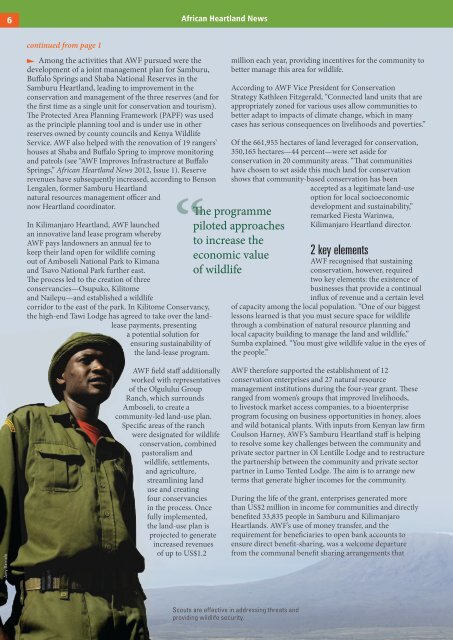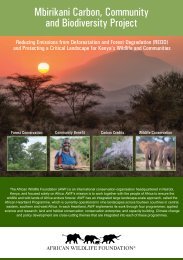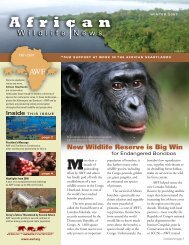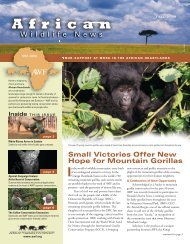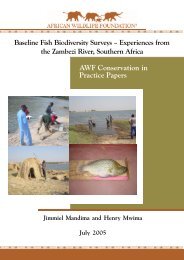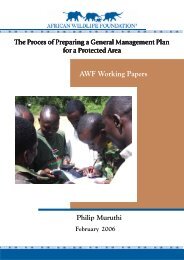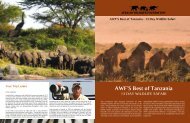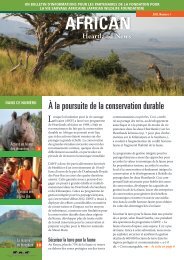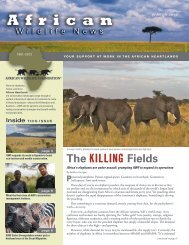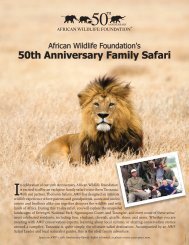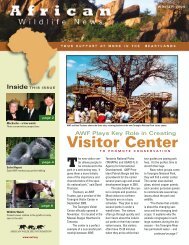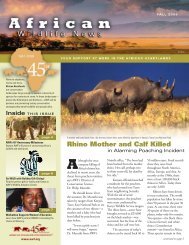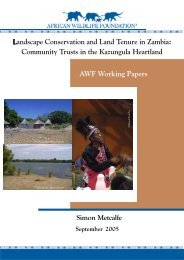Download (English) - African Wildlife Foundation
Download (English) - African Wildlife Foundation
Download (English) - African Wildlife Foundation
You also want an ePaper? Increase the reach of your titles
YUMPU automatically turns print PDFs into web optimized ePapers that Google loves.
6<br />
2 <strong>African</strong> Heartland News<br />
<strong>African</strong> Heartland News<br />
continued from page 1<br />
Among the activities that AWF pursued were the<br />
development of a joint management plan for Samburu,<br />
Buffalo Springs and Shaba National Reserves in the<br />
Samburu Heartland, leading to improvement in the<br />
conservation and management of the three reserves (and for<br />
the first time as a single unit for conservation and tourism).<br />
The Protected Area Planning Framework (PAPF) was used<br />
as the principle planning tool and is under use in other<br />
reserves owned by county councils and Kenya <strong>Wildlife</strong><br />
Service. AWF also helped with the renovation of 19 rangers’<br />
houses at Shaba and Buffalo Spring to improve monitoring<br />
and patrols (see “AWF Improves Infrastructure at Buffalo<br />
Springs,” <strong>African</strong> Heartland News 2012, Issue 1). Reserve<br />
revenues have subsequently increased, according to Benson<br />
Lengalen, former Samburu Heartland<br />
natural resources management officer and<br />
now Heartland coordinator.<br />
In Kilimanjaro Heartland, AWF launched<br />
an innovative land lease program whereby<br />
AWF pays landowners an annual fee to<br />
keep their land open for wildlife coming<br />
out of Amboseli National Park to Kimana<br />
and Tsavo National Park further east.<br />
The process led to the creation of three<br />
conservancies—Osupuko, Kilitome<br />
and Nailepu—and established a wildlife<br />
corridor to the east of the park. In Kilitome Conservancy,<br />
the high-end Tawi Lodge has agreed to take over the landlease<br />
payments, presenting<br />
a potential solution for<br />
ensuring sustainability of<br />
the land-lease program.<br />
million each year, providing incentives for the community to<br />
better manage this area for wildlife.<br />
According to AWF Vice President for Conservation<br />
Strategy Kathleen Fitzgerald, “Connected land units that are<br />
appropriately zoned for various uses allow communities to<br />
better adapt to impacts of climate change, which in many<br />
cases has serious consequences on livelihoods and poverties.”<br />
Of the 661,955 hectares of land leveraged for conservation,<br />
350,165 hectares—44 percent—were set aside for<br />
conservation in 20 community areas. “That communities<br />
have chosen to set aside this much land for conservation<br />
shows that community-based conservation has been<br />
accepted as a legitimate land-use<br />
option for local socioeconomic<br />
The programme<br />
piloted approaches<br />
to increase the<br />
economic value<br />
of wildlife<br />
development and sustainability,”<br />
remarked Fiesta Warinwa,<br />
Kilimanjaro Heartland director.<br />
2 key elements<br />
AWF recognised that sustaining<br />
conservation, however, required<br />
two key elements: the existence of<br />
businesses that provide a continual<br />
influx of revenue and a certain level<br />
of capacity among the local population. “One of our biggest<br />
lessons learned is that you must secure space for wildlife<br />
through a combination of natural resource planning and<br />
local capacity building to manage the land and wildlife,”<br />
Sumba explained. “You must give wildlife value in the eyes of<br />
the people.”<br />
Amy Barriale<br />
AWF field staff additionally<br />
worked with representatives<br />
of the Olgulului Group<br />
Ranch, which surrounds<br />
Amboseli, to create a<br />
community-led land-use plan.<br />
Specific areas of the ranch<br />
were designated for wildlife<br />
conservation, combined<br />
pastoralism and<br />
wildlife, settlements,<br />
and agriculture,<br />
streamlining land<br />
use and creating<br />
four conservancies<br />
in the process. Once<br />
fully implemented,<br />
the land-use plan is<br />
projected to generate<br />
increased revenues<br />
of up to US$1.2<br />
AWF therefore supported the establishment of 12<br />
conservation enterprises and 27 natural resource<br />
management institutions during the four-year grant. These<br />
ranged from women’s groups that improved livelihoods,<br />
to livestock market access companies, to a bioenterprise<br />
program focusing on business opportunities in honey, aloes<br />
and wild botanical plants. With inputs from Kenyan law firm<br />
Coulson Harney, AWF’s Samburu Heartland staff is helping<br />
to resolve some key challenges between the community and<br />
private sector partner in Ol Lentille Lodge and to restructure<br />
the partnership between the community and private sector<br />
partner in Lumo Tented Lodge. The aim is to arrange new<br />
terms that generate higher incomes for the community.<br />
During the life of the grant, enterprises generated more<br />
than US$2 million in income for communities and directly<br />
benefited 33,835 people in Samburu and Kilimanjaro<br />
Heartlands. AWF’s use of money transfer, and the<br />
requirement for beneficiaries to open bank accounts to<br />
ensure direct benefit-sharing, was a welcome departure<br />
from the communal benefit sharing arrangements that<br />
Scouts are effective in addressing threats and<br />
providing wildlife security.


